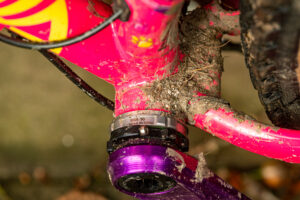Beautiful to behold and a joy to ride.
Trek Fuel EX Plus 9.8 27.5 (2017) review

Trail Bike of the Year in association with Alpinestars
The brand new Trek Fuel EX Plus bristles with acronyms, clever trademarks and proprietary features.
Familiar to many will be ABP, which combines the seatstay pivot, chainstay pivot and rear axle into a single part to save weight and improve suspension freedom under braking.
Watch now: Trail bike of the year 2017
Trek Fuel EX Plus 9.8 27.5
Full Floater tethers the shock to both the Evo rocker link and the extended chainstay, while the two-position Mino Link lets you tinker with the BB height and head angle.
>>> Trail Bike of the Year 2017
Just make sure you Loctite the bolts, or run a zip-tie through them, as we’ve had them fall out on us before during a ride.
Added to the list for 2017 are the Straight Shot down tube and Knock Block steering lock. Flattening the old s-bend down tube adds stiffness and saves weight, while the integrated steering lock and rubber bumper protects the OCLV carbon from fork crown damage in a crash.

Familiar looks and stealthy styling hide a host of changes
Suspension
Trek provides thorough guidance for setting up suspension on its website. Just select the right bike and input your weight, fully kitted up, and the calculator gives you recommendations for air pressure and damping. It’s an excellent tool and gives a great ballpark set-up.
Fox supplies the suspension on the Fuel EX Plus 9.8, namely a Float shock with extra volume EVOL can and RE:aktiv damper, paired with a 34 Float Performance fork.
The RE:aktiv shock adopts motorsport technology with the aim of improving stability and support when pedalling, while still opening up when it encounters a bump.
Does it work? Well, the suspension on the Fuel EX is exceptionally supple — at least the equal of the Specialized — so in that respect it’s class leading.
Harder to detect is any additional stability, support or efficiency over a standard well-tuned shock, although we did notice a slight knock in the firmer platform modes.
But keep the compression damping fully open and it’s super-compliant, nicely supportive, and easily taut enough when getting on the gas.
The same can be said of the 34 Performance suspension fork too, even with its less expensive GRIP damper. It might slot into the Fox hierarchy below the FIT4 on the Scott, but in the real world it’s hard to detect any loss of performance.

Knock Block prevents unwanted fork crown/down tube interaction
Components
We can’t fault the full Shimano XT drivetrain for shift quality or gear range, but we’d much rather see a lighter, simpler 1×11 system on the Trek.
That said, it’s fairly easy to de-clutter the Fuel EX yourself — all you need is a chain-retaining single ring.
Shimano’s XT disc brakes pack plenty of power, but the rear occasionally lacked a little consistency.
Bontrager’s own Chupacabra 2.8in tyres grace the 40mm Sun Ringle Duroc rims. It’s not a bad summer combo, but the shallow treaded rubber is no match for Maxxis’s more aggressive Rekon in mixed conditions.

Down tube is protected from the fork crown in the event of a crash
Performance
Trek deserves a rousing applause for its work on the Fuel EX Plus 9.8. Not only does it look menacing in its stealthy cloak, it rides like a total ninja too.
The suspension is super-sensitive, yet never suffers from the lack of progression that spoils the Specialized, and it displays a head-scratching momentum that trumps even the flighty Scott.
There’s an exceptional balance to the geometry that’s mirrored by the suspension response, and this puts you in the position and mindset to scorch every trail.
Helping matters further is one of the lowest bottom brackets we’ve ever encountered on a suspension trail bike. Yet, due to the slightly shorter travel and well-judged progression, we didn’t clip pedals anywhere near as often as we did on the Specialized.
As the icing on the cake, the quality of the OCLV carbon front triangle and seatstays shone through, with a well-damped, airy ride quality that’s the pick of the bunch.
Trek only misses the full standing ovation by virtue of being under-gunned in the tyre department and touting a seat angle that’s slacker than we’d like for seated climbing.

Verdict
Beautiful to behold and a joy to ride, the Trek Fuel EX Plus 9.8 is a triumph. The geometry would put some enduro bikes to shame, the frame is a delight, with a first-class ride quality, and it’s good value for a bricks-and-mortar brand. Back-to-back with the Scott, the Trek’s extra travel makes it the more versatile option, and if it was a bit cheaper it could have easily ridden away with the win in this category. But by the time you factor in a Maxxis tyre upgrade, the Trek’s £200 premium doubles. And that’s enough for the Scott to shade it.
















